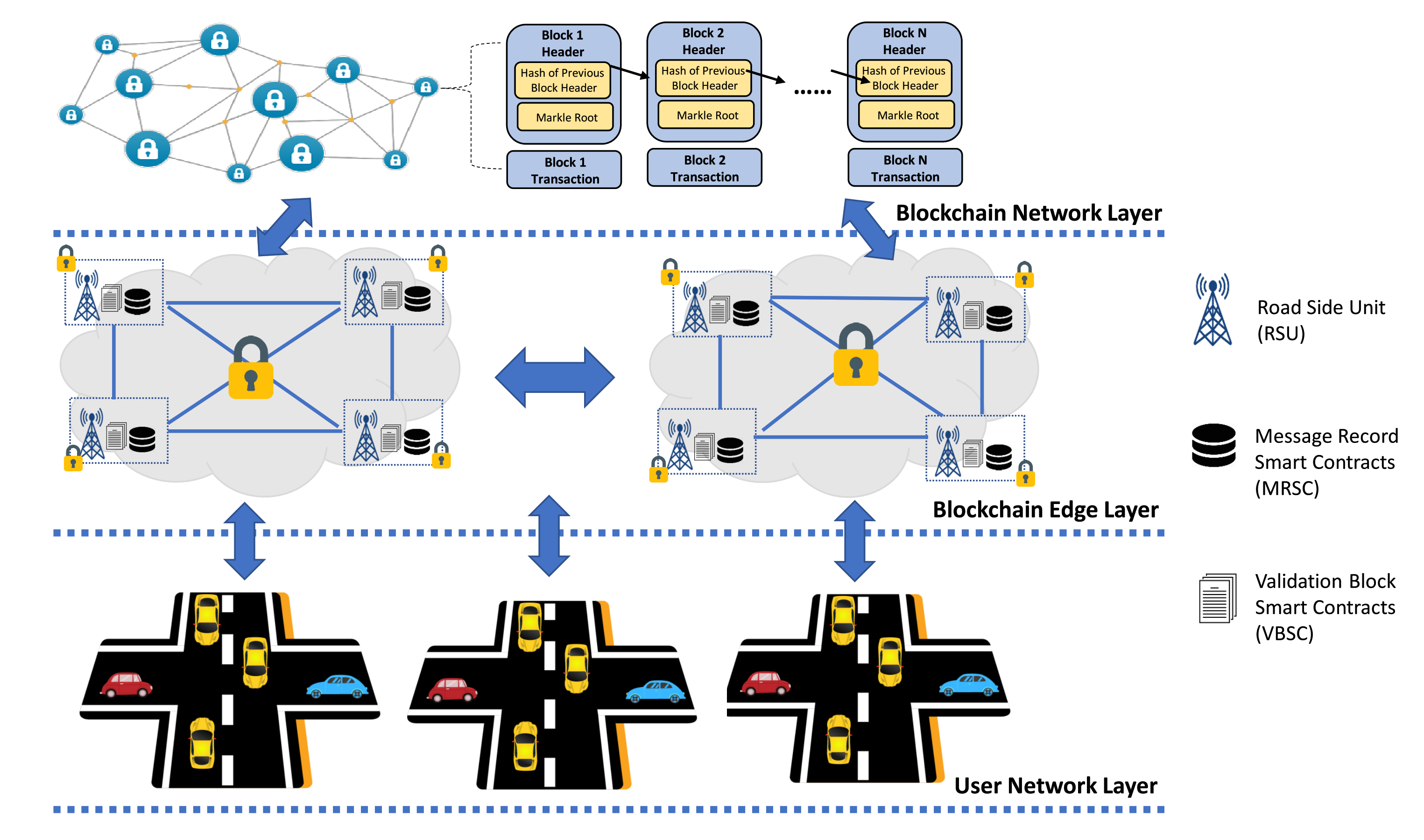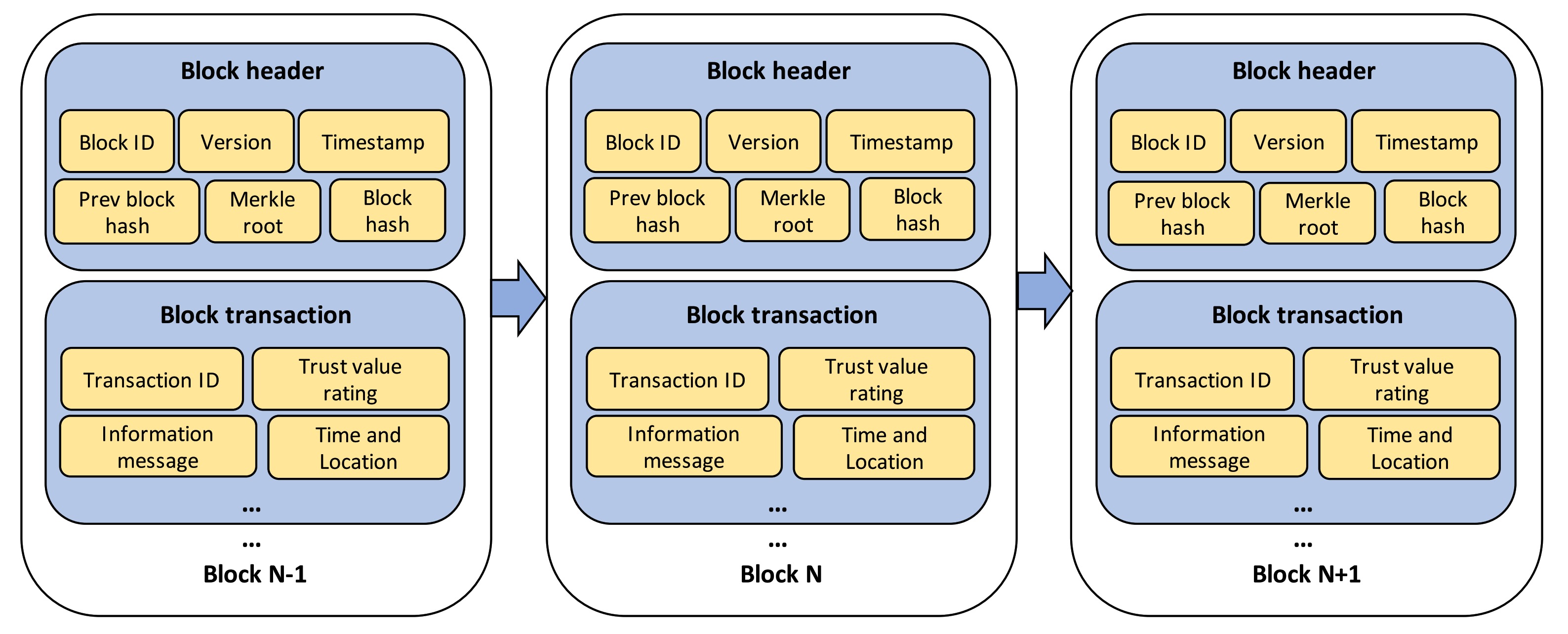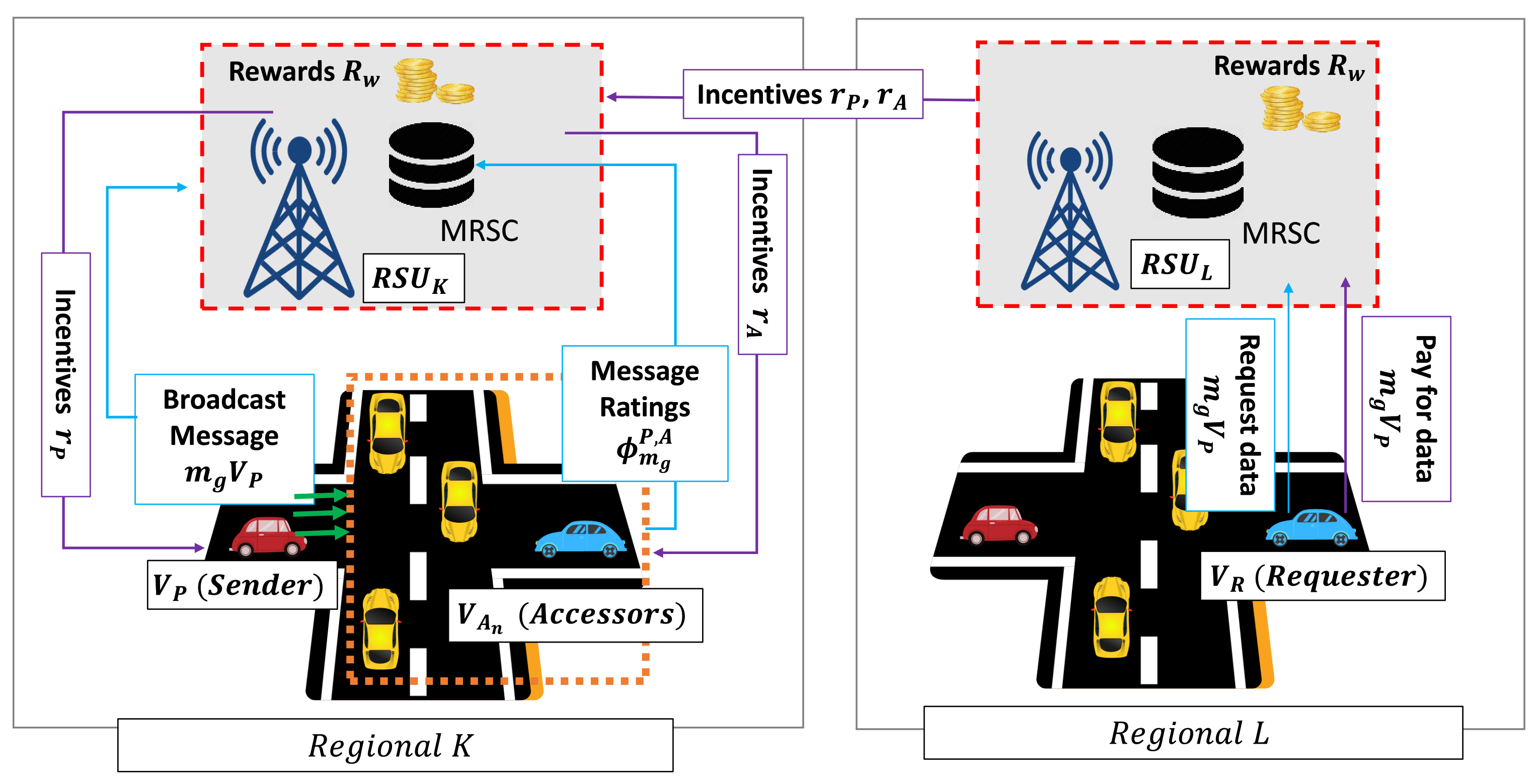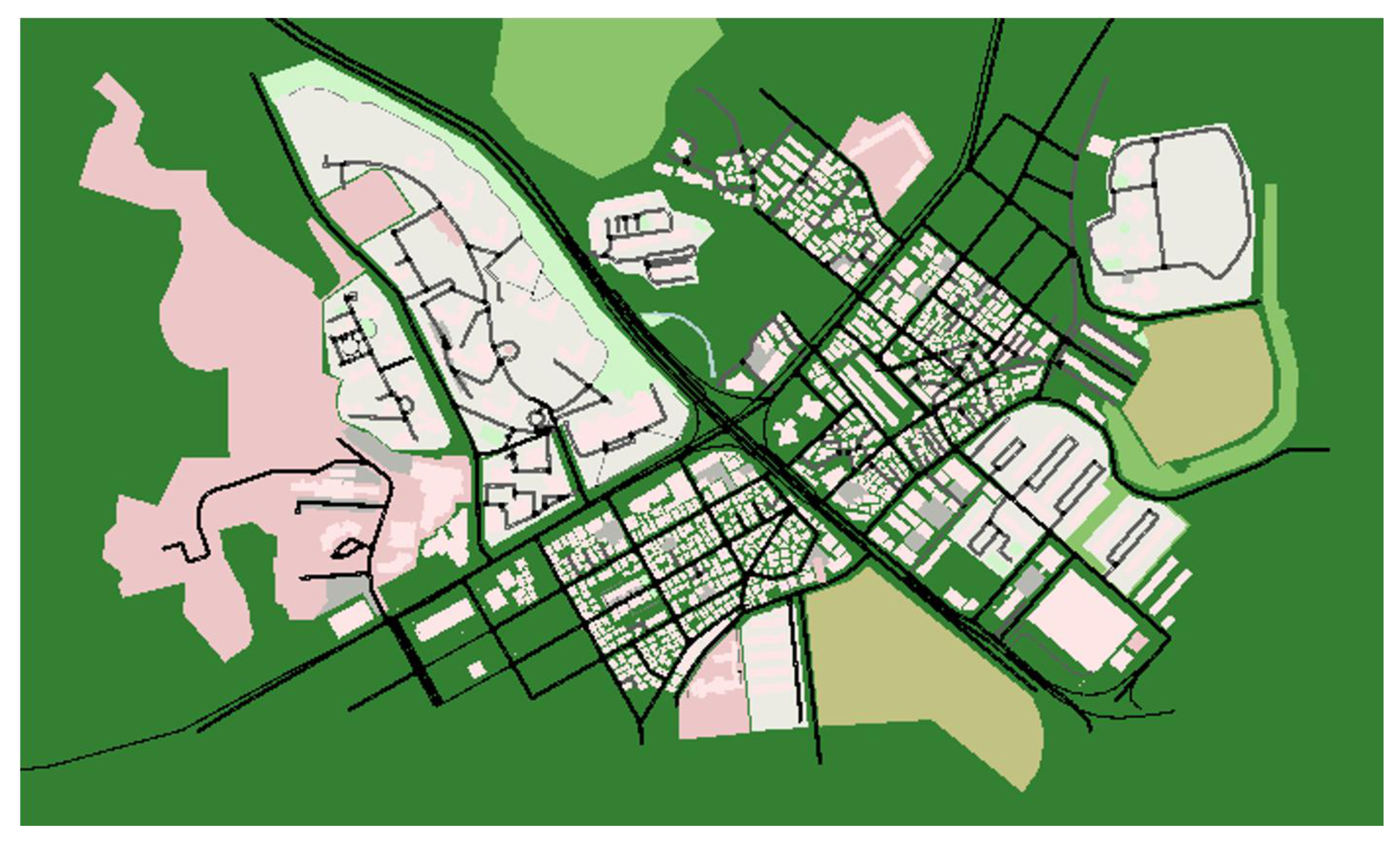Decentralized Trusted Data Sharing Management on Internet of Vehicle Edge Computing (IoVEC) Networks Using Consortium Blockchain
Abstract
1. Introduction
- 1.
- We design a decentralized trusted data sharing management framework for IoVEC networks by utilizing a consortium blockchain and smart contracts. This framework proposes a secure data sharing scenario among vehicles without relies on trusted intermediaries in distributed, verifiable, and immutable ledgers.
- 2.
- We present an information credibility assessment scenario to minimize irrelevant information data and against malicious behaviors of the vehicle on the data sharing process.
- 3.
- We design an appropriate incentive mechanism based on the vehicle’s contribution by leveraging smart contracts’ self-execution nature. This scheme aims to motivate vehicles to participate positively in maintaining trusted data sharing activities and ensuring the system’s security and sustainability.
- 4.
- We formulate a decentralized data sharing of IoV networks prototype and evaluate its performance based on simulation results.
2. Related Work
2.1. Internet of Vehicle Edge Computing (IoVEC) Networks
2.2. Conventional Data Sharing Management
2.3. Centralized Incentive Mechanism
2.4. Blockchain-Based Decentralized Data Sharing Management
3. The Framework of IoVEC-Blockchain for Trusted Data Management
3.1. User Network Layer
3.1.1. Vehicle Initialization and Enrollment
3.1.2. Message Credibility Assessment
3.2. Blockchain Edge Layer
3.2.1. Message Aggregation and Vehicle’s Reputation
3.2.2. Consensus Mechanism & Blockchain Generation
- Leader selection step: In consortium blockchain, RSUs are selected as validators to verify the block transaction in the consensus process. It is assumed that there are n edge nodes RSUs at region k, where . In each round r, a leader is responsible for storing into the blockchain network layer. The leader is chosen among the number of before the consensus process, and it does not change until after the consensus process.
- Request step: The request step represents a new candidate block generation process in MRSC. After MRSC aggregates , the result of will be validated using consensus mechanism in VBSC.
- Pre-prepare step: In this step, as shown in Figure 2, represents the RSU leader that broadcasts to all of the involved nodes or validators in the consensus mechanism process. Here, the validator nodes receive using its VBSC.
- Prepare step: Each validator verifies the and broadcasts the message verification among other authorized RSUs . In our scenario, we consider that portrays an anomalous node that ignores all validators’ verification request during consensus.
- Commit step: Then, the validators broadcast the commit message after receiving over of verification message from other validators in the prepare-step.
- Reply step: Finally, the leader proves that the consensus process on round r is finished after the consensus reaches over of the commit message and then uploads the verified block to the blockchain network. Thus, the distributed RSUs automatically obtain the log and authentication of , as well as update their ledger, simultaneously. Otherwise, the block will be rejected, and the system starts the next round consensus .
3.3. Blockchain Network Layer
4. Simulation and Results
4.1. System Setup
4.2. Message Credibility
4.3. Block Generation
4.4. Distributed Incentive Model
5. Discussion
6. Conclusions
Author Contributions
Funding
Institutional Review Board Statement
Informed Consent Statement
Data Availability Statement
Acknowledgments
Conflicts of Interest
Abbreviations
| IoV | Internet of Vehicle |
| ITS | Intelligent Transportation System |
| VANET | Vehicular Ad hoc Network |
| IoVEC | IoV Edge Computing Network |
| SPoF | Single Point of Failure |
| MEC | Mobile Edge Computing |
| PBFT | Practical Byzantine Fault Tolerance |
| RSU | Roadside Unit |
| OBU | Onboard Unit |
| V2I | Vehicle to Infrastructure Communication |
| V2V | Vehicle to Vehicle Communication |
| TP | Trusted Party |
| DSRC | Dedicated Short-Range Communication |
| MRSC | MEssage Record Smart Contract |
| VBSC | Validation Block Smart Contract |
| WAVE | Wireless Access for Vehicular Network |
| SUMO | Simulation of Urban Mobility |
| MAC/PHY | Medium Access Control/Physical Layer |
| OLSR | Optimized Link-State Routing |
| PDR | Packet Delivery Ratio |
References
- Jia, D.; Lu, K.; Wang, J.; Zhang, X.; Shen, X. A survey on platoon-based vehicular cyber-physical systems. IEEE Commun. Surv. Tutor. 2015, 18, 263–284. [Google Scholar] [CrossRef]
- Yang, Z.; Yang, K.; Lei, L.; Zheng, K.; Leung, V.C. Blockchain-based decentralized trust management in vehicular networks. IEEE Internet Things J. 2018, 6, 1495–1505. [Google Scholar] [CrossRef]
- Hu, Y.C.; Patel, M.; Sabella, D.; Sprecher, N.; Young, V. Mobile edge computing—A key technology towards 5G. ETSI White Pap. 2015, 11, 1–16. [Google Scholar]
- Liu, L.; Chen, C.; Pei, Q.; Maharjan, S.; Zhang, Y. Vehicular edge computing and networking: A survey. Mob. Netw. Appl. 2020, 1–24. [Google Scholar] [CrossRef]
- Xu, C.; Wang, Y.; Zhou, Z.; Gu, B.; Frascolla, V.; Mumtaz, S. A Low-latency and Massive-connectivity Vehicular Fog Computing Framework for 5G. In Proceedings of the 2018 IEEE Globecom Workshops (GC Wkshps), Abu Dhabi, UAE, 9–13 December 2018; pp. 1–6. [Google Scholar]
- Peng, D.; Wu, F.; Chen, G. Pay as How Well You Do: A Quality Based Incentive Mechanism for Crowdsensing. In Proceedings of the 16th ACM International Symposium on Mobile Ad Hoc Networking and Computing, Hangzhou, China, 22–25 June 2015; pp. 177–186. [Google Scholar]
- Jurca, R.; Faltings, B. An Incentive Compatible Reputation Mechanism. In Proceedings of the EEE International Conference on E-Commerce, 2003 (CEC 2003), Newport Beach, CA, USA, 24–27 June 2003; pp. 285–292. [Google Scholar]
- Nakamoto, S. Bitcoin: A Peer-to-Peer Electronic Cash System. Available online: https://bitcoin.org/bitcoin.pdf (accessed on 19 December 2020).
- Al-Jaroodi, J.; Mohamed, N. Blockchain in industries: A survey. IEEE Access 2019, 7, 36500–36515. [Google Scholar] [CrossRef]
- Treleaven, P.; Brown, R.G.; Yang, D. Blockchain technology in finance. Computer 2017, 50, 14–17. [Google Scholar] [CrossRef]
- Mettler, M. Blockchain Technology in Healthcare: The Revolution Starts Here. In Proceedings of the 2016 IEEE 18th International Conference on E-Health Networking, Applications and Services (Healthcom), Munich, Germany, 14–16 September 2016; pp. 1–3. [Google Scholar]
- Mengelkamp, E.; Notheisen, B.; Beer, C.; Dauer, D.; Weinhardt, C. A blockchain-based smart grid: Towards sustainable local energy markets. Comput. Sci. Res. Dev. 2018, 33, 207–214. [Google Scholar] [CrossRef]
- Firdaus, M.; Rhee, K.H. Empowering Blockchain For Secure Data Storing in Industrial IoT. In Proceedings of the Korea Information Processing Society Conference, Seoul, Korea, 29–30 May 2020; Korea Information Processing Society: Seoul, Korea, 2020; pp. 231–234. Available online: http://koreascience.or.kr/article/CFKO202024664104787.page (accessed on 5 January 2021).
- Yuan, Y.; Wang, F.Y. Towards Blockchain-based Intelligent Transportation Systems. In Proceedings of the 2016 IEEE 19th International Conference on Intelligent Transportation Systems (ITSC), Rio de Janeiro, Brazil, 1–4 November 2016; pp. 2663–2668. [Google Scholar]
- Kang, J.; Yu, R.; Huang, X.; Wu, M.; Maharjan, S.; Xie, S.; Zhang, Y. Blockchain for secure and efficient data sharing in vehicular edge computing and networks. IEEE Internet Things J. 2018, 6, 4660–4670. [Google Scholar] [CrossRef]
- Zhang, X.; Chen, X. Data security sharing and storage based on a consortium blockchain in a vehicular ad-hoc network. IEEE Access 2019, 7, 58241–58254. [Google Scholar] [CrossRef]
- Zhang, R.; Xue, R.; Liu, L. Security and privacy on blockchain. ACM Comput. Surv. (CSUR) 2019, 52, 1–34. [Google Scholar] [CrossRef]
- Li, Z.; Kang, J.; Yu, R.; Ye, D.; Deng, Q.; Zhang, Y. Consortium blockchain for secure energy trading in industrial internet of things. IEEE Trans. Ind. Inform. 2017, 14, 3690–3700. [Google Scholar] [CrossRef]
- Dai, Y.; Xu, D.; Maharjan, S.; Zhang, Y. Joint load balancing and offloading in vehicular edge computing and networks. IEEE Internet Things J. 2018, 6, 4377–4387. [Google Scholar] [CrossRef]
- Nguyen, T.D.; Nguyen, T.D.; Nguyen, V.D.; Pham, X.Q.; Huh, E.N. Cost-effective resource sharing in an internet of vehicles-employed mobile edge computing environment. Symmetry 2018, 10, 594. [Google Scholar] [CrossRef]
- Huang, X.; Yu, R.; Kang, J.; Zhang, Y. Distributed reputation management for secure and efficient vehicular edge computing and networks. IEEE Access 2017, 5, 25408–25420. [Google Scholar] [CrossRef]
- Kenney, J.B. Dedicated short-range communications (DSRC) standards in the United States. Proc. IEEE 2011, 99, 1162–1182. [Google Scholar] [CrossRef]
- Wang, D.; Zhang, X. Secure data sharing and customized services for intelligent transportation based on a consortium blockchain. IEEE Access 2020, 8, 56045–56059. [Google Scholar] [CrossRef]
- Lian, X.; Zhang, C.; Zhang, H.; Hsieh, C.J.; Zhang, W.; Liu, J. Can Decentralized Algorithms Outperform Centralized Algorithms? A Case Study for Decentralized Parallel Stochastic Gradient Descent. In Proceedings of the Advances in Neural Information Processing Systems, Long Beach, CA, USA, 4–9 December 2017. [Google Scholar]
- Guo, S.; Hu, X.; Guo, S.; Qiu, X.; Qi, F. Blockchain meets edge computing: A distributed and trusted authentication system. IEEE Trans. Ind. Inform. 2019, 16, 1972–1983. [Google Scholar] [CrossRef]
- Peng, C.; Wu, C.; Gao, L.; Zhang, J.; Alvin Yau, K.L.; Ji, Y. Blockchain for vehicular internet of things: Recent advances and open issues. Sensors 2020, 20, 5079. [Google Scholar] [CrossRef]
- Xiao, Y.; Liu, Y.; Li, T. Edge Computing and Blockchain for Quick Fake News Detection in IoV. Sensors 2020, 20, 4360. [Google Scholar] [CrossRef]
- Rahmadika, S.; Lee, K.; Rhee, K.H. Blockchain-Enabled 5G Autonomous Vehicular Networks. In Proceedings of the 2019 International Conference on Sustainable Engineering and Creative Computing (ICSECC), Bandung, Indonesia, 20–22 August 2019; pp. 275–280. [Google Scholar]
- Li, L.; Liu, J.; Cheng, L.; Qiu, S.; Wang, W.; Zhang, X.; Zhang, Z. Creditcoin: A privacy-preserving blockchain-based incentive announcement network for communications of smart vehicles. IEEE Trans. Intell. Transp. Syst. 2018, 19, 2204–2220. [Google Scholar] [CrossRef]
- Javed, M.U.; Rehman, M.; Javaid, N.; Aldegheishem, A.; Alrajeh, N.; Tahir, M. Blockchain-Based Secure Data Storage for Distributed Vehicular Networks. Appl. Sci. 2020, 10, 2011. [Google Scholar] [CrossRef]
- Firdaus, M.; Rhee, K.H. On Blockchain-Enhanced Secure Data Storage and Sharing in Vehicular Edge Computing Networks. Appl. Sci. 2021, 11, 414. [Google Scholar] [CrossRef]
- Raya, M.; Papadimitratos, P.; Gligor, V.D.; Hubaux, J.P. On Data-centric Trust Establishment in Ephemeral ad hoc Networks. In Proceedings of the IEEE INFOCOM 2008—The 27th Conference on Computer Communications, Phoenix, AZ, USA, 13–18 April 2008; pp. 1238–1246. [Google Scholar]
- Castro, M.; Liskov, B. Practical Byzantine fault tolerance and proactive recovery. ACM Trans. Comput. Syst. TOCS 2002, 20, 398–461. [Google Scholar] [CrossRef]
- Morrison, D.R. PATRICIA—Practical algorithm to retrieve information coded in alphanumeric. J. ACM 1968, 15, 514–534. [Google Scholar] [CrossRef]
- Ampel, B.; Patton, M.; Chen, H. Performance Modeling of Hyperledger Sawtooth Blockchain. In Proceedings of the 2019 IEEE International Conference on Intelligence and Security Informatics (ISI), Shenzhen, China, 1–3 July 2019; pp. 59–61. [Google Scholar]
- Olson, K.; Bowman, M.; Mitchell, J.; Amundson, S.; Middleton, D.; Montgomery, C. Sawtooth: An Introduction; The Linux Foundation: San Francisco, CA, USA, 2018. [Google Scholar]
- Jaiswal, R.K.; Jaidhar, C.D. An Applicability of AODV and OLSR Protocols on IEEE 802.11 p for City Road in Vanet. In Internet of Things, Smart Spaces, and Next Generation Networks and Systems; Springer: Cham, Switzerland, 2015; pp. 286–298. [Google Scholar]
- Gudgeon, L.; Moreno-Sanchez, P.; Roos, S.; McCorry, P.; Gervais, A. SoK: Layer-two Blockchain Protocols. In Proceedings of the International Conference on Financial Cryptography and Data Security, Kota Kinabalu, Malaysia, 14 February 2020; Springer: Cham, Switzerland, 2020; pp. 201–226. [Google Scholar]
- Kokoris-Kogias, E.; Jovanovic, P.; Gasser, L.; Gailly, N.; Syta, E.; Ford, B. Omniledger: A Secure, Scale-out, Decentralized Ledger via Sharding. In Proceedings of the 2018 IEEE Symposium on Security and Privacy (SP), San Francisco, CA, USA, 20–24 May 2018; pp. 583–598. [Google Scholar]
- Eyal, I.; Gencer, A.E.; Sirer, E.G.; Van Renesse, R. Bitcoinng: A Scalable Blockchain Protocol. In Proceedings of the 13th USENIX Symposium on Networked Systems Design and Implementation (NSDI 16), Santa Clara, CA, USA, 16–18 March 2016; pp. 45–59. [Google Scholar]










| Symbol | Description |
|---|---|
| The legitimate vehicle in the network | |
| , | The vehicle’s public and private key pair |
| TP | The trusted party for managing vehicle enrollment |
| The vehicle’s corresponding certificate | |
| The provider vehicle that share the road-related message | |
| The assessor vehicle that assess the road-related message from | |
| The road-related message from the legitimate vehicle | |
| The information message from | |
| The collected information message by in t time and location k | |
| The credibility of the message | |
| The message credibility assessment uploaded by | |
| The message rating of generated by | |
| The new block candidate that will be validated in consensus mechanism | |
| The aggregated trust value of according to |
| Parameter | Value |
|---|---|
| number of Vehicles | 26 |
| vehicle speed | 20 m/s |
| WAVE ITS band | 5.9 GHz |
| MAC type | IEEE 802.11p |
| physical mode | OFDM (6 Mbps rate) |
| the type of routing protocol | OLSR |
| transmission rate | 2.048 Kbps |
| the model of propoagation loss | Two-ray ground |
| fading model | Nakagami fading |
| data rate | 6 Mbps |
| power transmission | 20 dBm |
| packet interval | 100 ms |
| data rate | 6 Mbps |
| channel bandwidth | 10 MHz |
| antenna height | 1.5 m |
| simulation time | 100 s |
| Vehicle Neighbors | Distance from | Message Credibility [0–1] | Accuracy Reduction [0–1] |
|---|---|---|---|
| 50 m | 0.9430 | 0.0570 | |
| 100 m | 0.912905 | 0.0871 | |
| 150 m | 0.89447 | 0.1055 | |
| 200 m | 0.874277 | 0.1257 | |
| 250 m | 0.841686 | 0.1583 | |
| 300 m | 0.791951 | 0.2080 | |
| 350 m | 0.709643 | 0.2904 | |
| 400 m | 0.709643 | 0.2904 | |
| 450 m | 0.709643 | 0.2904 | |
| 500 m | 0.709643 | 0.2904 |
| Vehicle (Message Provider) | Message Size | Incentive (Ether) | Exp. 1 GU (Units) | Exp. 2 GU (Units) | Regional |
|---|---|---|---|---|---|
| 112 bits | 0.0001 | 117,987 | 118,086 | L→ K | |
| 213 bits | 0.0002 | 117,888 | 117,993 | L→ K | |
| 304 bits | 0.0003 | 118,003 | 117,953 | L→ K | |
| 414 bits | 0.0004 | 117,779 | 117,854 | L→ K | |
| 513 bits | 0.0005 | 117,960 | 117,861 | L→ K | |
| 600 bits | 0.0006 | 117,891 | 117,792 | K→ L | |
| 711 bits | 0.0007 | 117,985 | 118,084 | K→ L | |
| 807 bits | 0.0008 | 117,923 | 118,022 | K→ L | |
| 904 bits | 0.0009 | 117,969 | 118,029 | K→ L | |
| 1007 bits | 0.001 | 118,063 | 117,987 | K→ L |
| Key Parameter/Technology | Yang et al. [2] | Kang et al. [15] | Zhang et al. [16] | Proposed System |
|---|---|---|---|---|
| Blockchain type | Public | Consortium | Consortium | Consortium |
| MEC technology | No | Yes | No | Yes |
| Message credibility assessment | Yes | No | No | Yes |
| Consensus mechanism | Joint PoW and PoS | Joint PoW and PoS | Joint PoW and PBFT | PBFT |
| Incentive scheme | No | No | No | Yes |
Publisher’s Note: MDPI stays neutral with regard to jurisdictional claims in published maps and institutional affiliations. |
© 2021 by the authors. Licensee MDPI, Basel, Switzerland. This article is an open access article distributed under the terms and conditions of the Creative Commons Attribution (CC BY) license (https://creativecommons.org/licenses/by/4.0/).
Share and Cite
Firdaus, M.; Rahmadika, S.; Rhee, K.-H. Decentralized Trusted Data Sharing Management on Internet of Vehicle Edge Computing (IoVEC) Networks Using Consortium Blockchain. Sensors 2021, 21, 2410. https://doi.org/10.3390/s21072410
Firdaus M, Rahmadika S, Rhee K-H. Decentralized Trusted Data Sharing Management on Internet of Vehicle Edge Computing (IoVEC) Networks Using Consortium Blockchain. Sensors. 2021; 21(7):2410. https://doi.org/10.3390/s21072410
Chicago/Turabian StyleFirdaus, Muhammad, Sandi Rahmadika, and Kyung-Hyune Rhee. 2021. "Decentralized Trusted Data Sharing Management on Internet of Vehicle Edge Computing (IoVEC) Networks Using Consortium Blockchain" Sensors 21, no. 7: 2410. https://doi.org/10.3390/s21072410
APA StyleFirdaus, M., Rahmadika, S., & Rhee, K.-H. (2021). Decentralized Trusted Data Sharing Management on Internet of Vehicle Edge Computing (IoVEC) Networks Using Consortium Blockchain. Sensors, 21(7), 2410. https://doi.org/10.3390/s21072410






